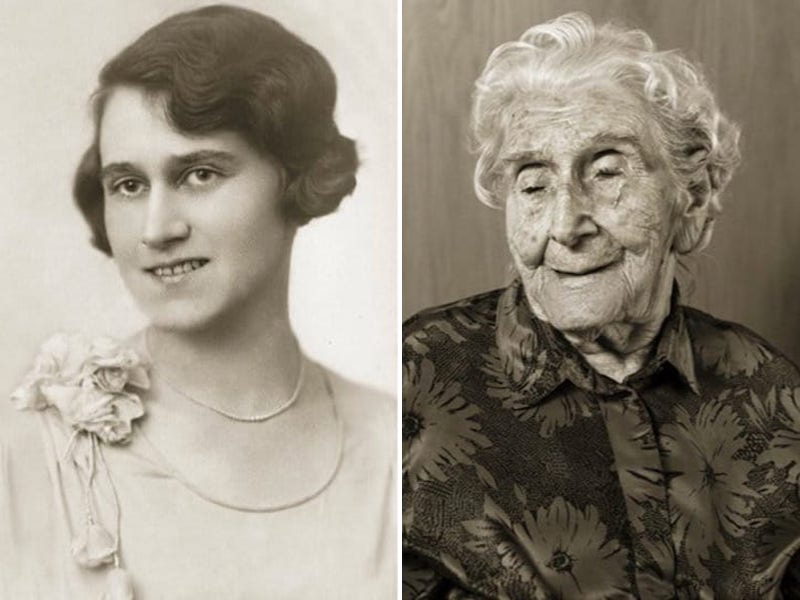- Opava-based photographer Jan Langer captured sentimental portraits of elderly Czechs for his photo series, “Faces of Century.”
- Langer believed the media did not cover the lives of the elderly enough, so he set out to capture them in a new light.
- He set an age limit for his subjects of at least 100 years old.
- Langer’s photo series features side-by-side portraits of his subjects as a young adult and as a centenarian.
- Visit Insider’s homepage for more stories.
Centenarians – people who are 100 years or older – are considered a rare demographic.
But as life expectancy increases around the world, the number of centenarians is expected to grow quickly. According to U.N. estimates, there were 343,000 centenarians worldwide in 2012, a figure that Pew Research says is projected to grow by 3.7 million in 2050.
Opava-based photographer Jan Langer decided to shed new light on this population, showing readers what it’s like to be 100 years old through his photo series, “Faces of Century.” The sentimental portraits feature side-by-side comparisons of the elderly as young adults versus now.
Keep scrolling to see Langer’s portraits and to learn the inspiration behind them.
Opava-based photographer Jan Langer's "Faces of Century" photo series features side-by-side portraits of Czechs as a young adult and as a centenarian.

As a teenager, Langer experimented with expressing feelings through black-and-white photography.
"I have been always fascinated by people and their stories," Langer explained. "So I started to photograph social topics and my closest friends from my hometown before going on to get my master's degree in photography."
He was inspired to shed more light on the lives of elderly people after finding that there was a lack of media coverage surrounding the population.

Langer knew that he wanted to document the lives of elderly people in some way, but didn't know how just yet.
He was inspired to start the photo series after meeting a woman who recounted her experiences while looking through a box of old portraits and family photographs. Langer found it to be "kind of mysterious" hearing her remember things that happened more than 80 years ago.
But finding subjects to capture for the photo series was not an easy task for Langer.

"I spent a long time researching and corresponding with local authorities and families," Langer reflected. "I addressed each one of them in writing and sent them a project proposal with my idea."
Once he finally found a respondent, it took Langer anywhere from two hours to half a day to capture an image that he loved.
His hope was to capture how people changed over the years using side-by-side comparisons.

Each portrait in the series is composed of a side-by-side comparison of the subjects, which show the similarities and differences in physical characteristics.
Langer also spent time interviewing his subjects and learning about their occupation, hobbies, relationships, memories, and wishes.
He tried to make the new photos look as similar to the originals as possible.

Langer attempted to reconstruct the same picture by studying the light of the photo, in addition to body position, expression, and composition. He posed his subjects in a similar way to the original image and then adjusted the lighting accordingly.
To Langer's surprise, his models naturally expressed themselves similarly to the original portraits.

"I found that I did not have to press my models to express any specific kind of feeling or mood in order to make them appear similar to their photos from 70 or 80 years ago," Langer said.
Although his subjects changed physically, Langer noted that ultimately, they remained the same at their core.

"Of course, the people change physically," Langer said.
"They also become more experienced, humble, enlightened, or just tired," he added. "But in a way, they also stay the same. The characteristics of personality change throughout life, but it seems as if individual nature remains rooted in the abyss of time."
All of the people Langer photographed have their own unique stories to tell, especially having lived through major world events.

"In the Czech Republic, these people have lived through world wars, communist regimes, occupation by Russians, capitalism in the '90s, the boom of new technologies, and more," said Langer.
Through his time capturing these photographs, Langer also found himself reflecting on his own life experiences.

"The moments that could be the ones you will remember at the end of your life come unobserved, but they are usually not connected to our professional career," Langer noted. "It is often part of our childhood or family relations that form our life frame at its end."
Through listening to his subject's stories, Langer reflected on his own experience of trying to enjoy the trivial moments with his family, as well as being more conscious of the time or space he's in
And many people have had a similar reaction after viewing the photos from Langer's series.

When asked how people react when they see these photos, Langer said that "most people feel touched."
"Upon viewing the photos, they realize that they will be old one day," he said, "All of them will have to face this old age, and many of them will evaluate their life. Was it a good life? Did I live it in a good way?"
At its core, this photo series taught Langer that life is "too short to live it quickly."

Conversations with his subjects allowed him to observe that at the end of life, his muses were more reflective on the relationships that they've built over time, rather than the successes achieved in their careers.
And that living in the moment is invaluable.

"Many of the people I photographed have their own stories, which enriched my life in ways I would have never experienced without meeting them face-to-face," Langer said.
Each of the subjects captured in this series "lived a rich and colorful life full of big changes and experiences," according to Langer.

One of his subjects, Marie Fejfarová, burned all of the material memories of her life, including letters, diaries, and photographs, before deciding to move to a long-term care facility.
The example demonstrates how she believed in being able to start a new chapter at any point in life.
You can view the entire collection and read more about each individual on Langer's website.










